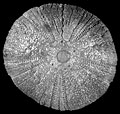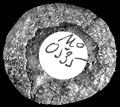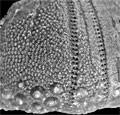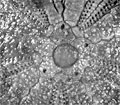The Echinoid Directory
Contributed by Andrew Smith, November 2006
Baronechinus Vadet, 2005, p. 29
| Diagnostic Features |
|
|---|---|
| Distribution | Lower Jurassic (Pliensbachian), Morocco. |
| Name gender | masculine |
| Type | Baronechinus baroni Vadet & Nicolleau, 2005, p. 29, by original designation. |
| Species Included | Only the type species. |
| Classification and/or Status | Euechinoidea, Echinacea, Stomechinidae |
| Remarks |
This taxon appears very similar to some arbacioids, such as Codiopsis, in having enlarged aboral pores uniserially arranged. However, its ambulacral plating is very different, with all three elements in a triad equal in size and extending to the median suture. |






